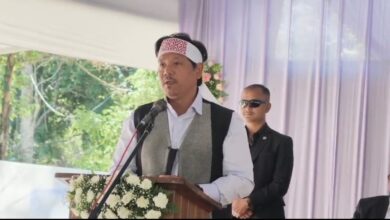Return of guns in Garo Hills
The recent killing of a militant sympathiser & recovery of arms point at the possibility of resurgence of militancy in the region

The killing of Sohan D Shira, the dreaded chief of the Garo National Liberation Army (GNLA), in 2018 marked the end of insurgency in Garo Hills. The region that, for years, remained under-developed and unnoticed by the tourism sector finally breathed easy and saw hope of turning around. Local entrepreneurs started foraying into tourism business and the state government took up several development schemes which were elusive for a long time.
But the recent killing of a militant sympathiser at Daldagre in West Garo Hills and recovery of arms and ammunition from his possession have left many wondering whether the region is again slipping into the murkiness of insurgency.
According to a statement by the West Garo Hills police, the man, identified as Robison R Marak, was on a two-wheeler and carrying a bag. When the police tried to stop him, he took out an assault rifle from the bag and started shooting at the police team. In retaliation, police also fired killing Marak. Later, police recovered an AK-56 rifle and sacks of ammunition. Marak, who was from Tikrikilla, worked as an overground worker for several militant groups in Garo Hills and was allegedly involved in criminal activities like kidnapping and extortion.
The encounter came days after Mukul Sangma claimed that surrendered militants in Garo Hills are returning to the forests for regrouping. It was during Sangma’s tenure that GNLA was neutralised before the state elections in 2018.
Looking back
Garo Hills plunged into complete chaos after the GNLA was formed in the early part of this millennium and quickly turned into a criminal group without ideology. The militants would engage in extortion, killings, bomb blasts, kidnapping and blackmail.
The outfit gave ersatz hope of liberation from the corrupt system to the unemployed youths in Garo Hills and put weapons in their hands. A generation that was already frustrated with the failure of the state government was gullible and could easily be sucked into militancy.
What followed was an era of lawlessness. Extortions and threats kept businessmen and potential investors away from Garo Hills. Frequent reports of abduction and assault put fear in the minds of outsiders who saw Garo Hills as a “militant-infested place” and should be avoided. The region barely saw development. The already backward places were pushed further into the darkness.
The cycle of violence and terror finally ended with Shira’s death. A local entrepreneur who runs a traditional homestay in West Garo Hills had told this reporter in 2019 that with the end of militancy, there is hope that tourism would flourish and “we will do our best to promote the beautiful places in the region”.
Is the fear back?
However, Mukul’s remark on regrouping of militants and the recent killing have made people jittery. Congress leader from Tura Beryl B Sangma says there are two major reasons for the regrowth of militancy.
“When the GNLA surrendered en masse and kept in camps, they were quiet for some time. According to the peace agreement, these surrendered militants were supposed to get some benefits, which they did not receive. That became one reason for them to be dissatisfied. Another reason was the social stigma. Though the militants came back to normal life, society still stigmatised them, making it difficult for them to lead a normal life. They were pushed to the periphery,” says Beryl.
Not only that, those working with militant groups got used to getting easy money by wielding guns and the real hardship of life was overwhelming for them. Regrouping as militants is an easier option.
Sources said there were reports of NDFB in Assam supplying weapons to the former militants here.
But these are just external catalysts for militancy to grow or resume. A major reason for insurgency is socio-economic. With over 5% unemployment rate, no industrial growth and limited job opportunities in government departments, the youths are in disarray.
According to Tengsak G Momin, president of the Garo Students’ Union, the coal trade in the region was one reason for the growth of militant outfits which would extort money from miners. “But with the ban on coal mining, the outfits faced severe fund crunch. Even for regrouping, they do not have enough fund,” he adds.
Timber traders were also targeted by militant groups and there were several attacks on merchants in the nineties, says a senior journalist from Garo Hills.
The road ahead
The situation in remote villages never changed and the fear of extortion exists even after the militants were tamed for a short period. Jaynie N Sangma, a prominent social worker in Tura, narrates the story of a group of villagers that created terror in the locality.
“I was working on a case where three villagers were made pariah by others in the village. Initially, I thought it was a case of witch-hunt but during my investigation I found out that those people who were running away from their home would exploit the poor villagers and force them to cough up money. They would take money from agriculturists and cashew planters,” she says.
Now, when a possible regrouping is happening and former militants are taking up arms which were stashed away, the political blame game has started. While the opposition is blaming the current government for its “failure” to maintain law and order, the ruling party is pointing finger at its predecessor for not doing enough to rehabilitate the surrendered insurgents.
Beryl says both the previous and the current governments have to be blamed for the worsening situation. According to him, there was no follow-up of the rehabilitation cases and the surrendered militants did not get the dues they deserved. He also blames the current home minister for setting a bad precedent by offering to step down.
“How can he do that? What kind of message is he sending to the youths? How can he be perturbed by a few threats and run away from responsibilities? This does not augur well with the citizens,” he adds.
Beryl was referring to Lahkmen Rymbui’s decision to resign following the killing of another surrendered militant, Cherishstarfield Thangkhiew in Shillong.
Thangkhiew, a former HNLC top leader who surrendered in 2018, was shot by the police during an early-morning raid on his house. The police statement said he tried to attack the team with a knife and in retaliation he was fired at. The theory is similar to what happened to Robison.
The Congress leader also points out that intelligence reports on regrouping of militants were ignored by the current government that took the matter lightly.
The current government should have been more vigil and kept its finger on the pulse of Garo Hills to monitor the situation. But time is still on its side. All it has to do is show alacrity.
It is also time that all public representatives in the state abstain from mudslinging and show political will to end militancy. Education, says Jaynie, is important to empower youths.
Development and empowerment of youths are the only means to stop their participation in insurgency and petty crime.
“There has always been a demand for development. We have also been asking the Centre to provide some scheme to encourage entrepreneurship in the region. There has to be some business opportunity for youths so that militancy can be countered. The youths have to productively engaged in the society,” says Tengsak.
Garo Hills has started to see progress and the momentum should not be disturbed. The resurgence of militancy can derail development schemes once again, and before it happens, there has to be a two-pronged action — end the regrouping and ensure enough development.
~ Team Sunday Monitor





